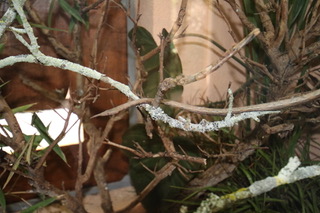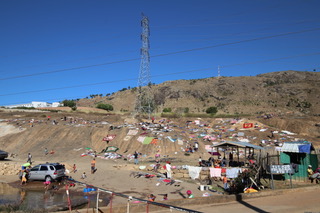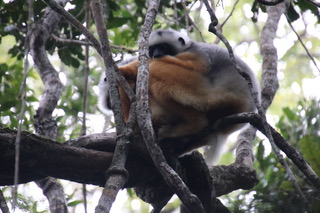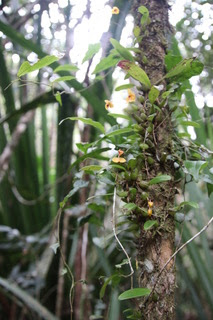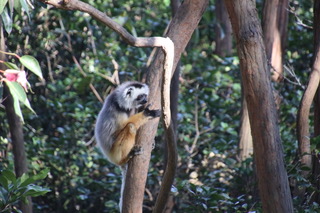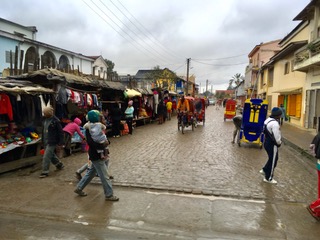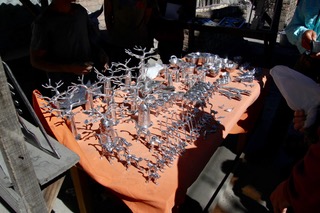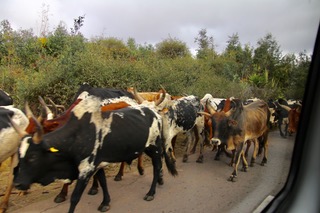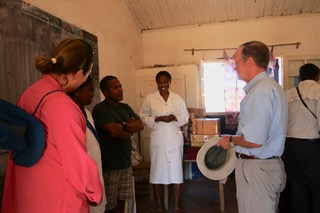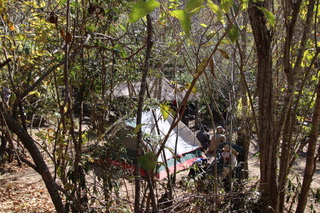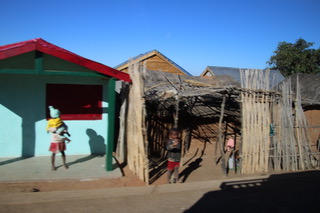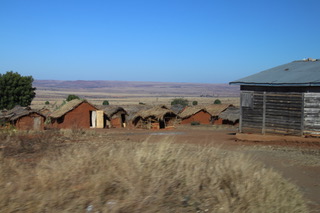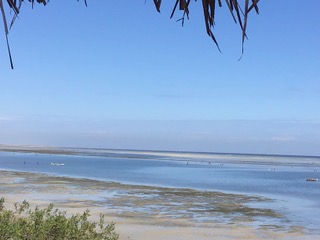Thursday-Friday, July 18-19. We flew 15 hours from JFK to Nairobi on Kenya Airways, and changed there for another 3 1/2-hour flight to Antananarivo ("Tana" to the locals), Madagascar's capital ... a 9,300 mile journey. We noticed this striking sculpture in Jomo Kenyatta International Airport in Nairobi as we changed planes. We were happy to have an early, quiet dinner and get to sleep after arriving at our hotel near Tana's airport.
Saturday, July 20. After breakfast, with some of our fellow travelers still in transit, we joined another couple for an unscheduled taxi ride to the "Croc Farm," a wildlife and nature park.
The Croc Farm had quite a bit more than crocs ... among a number of indoor displays, we saw this very large and very well-camouflaged chameleon ...
... and this unbelievably well-camouflaged "Twig Snake" ... can you see its very pointy nose and head to the left of the center of this photo?
A number of larger animals inhabited outdoor cages and enclosures. This Fossa is Madagascar's only endemic land predator, and is seldom seen in the wild.
The Croc Farm also housed several species of large land tortoises.
There are no venomous snakes in Madagascar, but there are plenty of nonvenomous species and this is a pretty big one!
The pathways were lined with lots of endemic plant species, including this display of large cacti ...
... and we also encountered some "free range" birds, like this little flock of beggers.
But they don't call it the Croc Farm for nothin' ... and these massive Nile Crocodiles are indeed the stars of the show. As their name implies, Nile Crocodiles are not native to Madagascar; the French imported them in the late nineteenth century to, yes, "farm" them. As you would expect, they did not all stay safely in captivity, and so today they are the other land predator in Madagascar alongside the Fossa.
The Croc Farm has more than 150 Nile Crocodiles ... quite a spectacle to see them all sunning on the banks of this large walled lagoon on a warm, sunny day!
We had a nice lunch by the pool after returning from the Croc Farm. Then we gathered with our fellow travelers to meet our guide, Alain Rakotonoely for an orientation. A history professor from the university in Antananarivo provided a nice overview of Madagascar history. To summarize, migrants from South Asia, Arabia and Africa settled the island beginning in the 7th century A.D. Ultimately, some 18 tribes developed, each speaking a dialect of Malagasy, the common language. Local tribal kings in the northern part of the island participated in the slave trade, selling slaves to obtain guns and ammunition to expand their kingdoms. Great Britain helped the king of Antananarivo become the "King of Madagascar" in 1817. He was the first of six kings and queens who ruled until 1896. In 1870, the Congress of Vienna settled a number of territorial claims by European powers, and France gained rights with respect to Madagascar while the British were granted rights in Mauritius. In 1895, Madagascar became a French protectorate and a colony the following year, ending the kingdom era. Madagascar achieved its independence in 1960, and has since been governed by a series of republics based on the French institutional model.
Sunday, July 21. After breakfast, we drove to Ambohimanga to visit the Royal Palace, a UNESCO World Heritage Site. This photo shows the exterior courtyard that was used for public events; the sovereign would appear on top of the wall to be seen and heard by the people assembled below. Zebu (a variety of cattle with a large hump imported from India) were sacrificed in the courtyard on important occasions ... a tradition that continues to this day as evidenced by a number of zebu skulls in the wall.
This is the Queen's Summer Cottage inside the Palace.
The covered deck surrounding its upper floor provided panoramic views of the surrounding countryside. The Palace enclosure also contained a separate one-room residence for the King, ceremonial baths in which the sovereign bathed once a year (and the people drank the bathwater!) and the tombs of the sovereigns.
This large gate protected the entrance to the Palace area in the kingdom era. A huge circular stone could be rolled across the entrance to seal the area completely.
After this tour we drove to Andasibe, stopping for a nice lunch that included this fruity dessert.
During lunch, a local family entertained us with folk songs and dances. The little boy in the middle of the photo was clearly the star of the show!
On the way to Andasibe, we saw many people doing laundry in small creeks and streams, and drying it on the ground ... we would see this continuously all over Madagascar, as this is a deeply ingrained social custom.
Monday, July 22. After breakfast at our forest lodge in Andasibe, we spent the day exploring the Analamazaotra Special Reserve with this very able local guide ... here pointing out an incredible set of vines.
Here's a bird nest fern growing on the side of a tree, so-named because birds build nests in them.
We walked past a tilapia farm, with a convenient perch for this interesting bird.
Our first sighting of a leaping lemur! They can leap up to 10 meters from branch to branch, and it is amazing to see.
Two more Common Brown Lemurs.
There are around 60 species of lemurs. This is a pair of Diademed Sifakas.
This Indri, the largest species of lemur, was howling ... quite an amazing sound!
Madagascar is also home to half of the chameleon species in the world, and this Parson's Chameleon is the largest ... about a foot long.
Look very closely ... can you spot the two birds snuggled together on the ground? Hint: focus your attention just to the right of the center of the photo. What amazing camouflage!
Madagascar has nearly 1000 species of orchids, 85% of which are endemic. Although winter isn't the best season to see them, we did see some like these growing on a tree.
Here's an Indri contemplating the universe, and perhaps his place in it.
Geckos seem to be almost everywhere you look in the forest, and here's a tiny one.
We saw a number of the fascinating bird nests ... the bird enters and exits at the bottom of the long tunnel hanging down from the actual nest area ... great protection from predators.
An Eastern Gray Bamboo Lemur.
After dark, but before dinner, we took a nightwalk along a road and spied this cute little bird ...
... an Eastern Woolly Lemur (sorry about the poor photo quality) ...
... and this Small-Toothed Sportive Lemur, maybe 6 inches high. A great find to cap a great day!
Tuesday, July 23. This morning, we went to a remote rain forest in a set of 4x4 vehicles. Once there, we started out with our local guide on trails like this one, while spotters moved further into the forest to find the lemurs.
In order to get to the lemurs, we had to go off trail and into some very challenging areas of the forest.
Soon enough, we were rewarded with sightings of this Black and White Ruffed Lemur ...
... and this Red Bellied Lemur.
Along the trail, we came across this Madagascar Giant Snail, yet another species endemic to the island.
Here's another very interesting bird nest ... this one for the Paradise Flycatcher.
As we neared our vehicles to return to our lodge, we saw this unique species of bamboo that looks like a vine.
Here's Pam with our spotter, who did a great job helping us locate the lemurs in the almost-impenetrable rain forest!
After lunch at the lodge, we visited Lemur Island, founded by the lodge to provide sanctuary to displaced lemurs that were formerly pets and are not suitable for reintroduction to the wild. The island is a mere stone's throw across the water ... maybe the world's shortest canoe ride, but lemurs will not go into the water under any circumstances and it's too far for them to leap across.
As you can see, some of the lemurs are extremely habituated to people! This one jumped right on Paul as soon as we got out of the canoe.
Fortunately, this one jumped off before Paul got too tired of holding him up!
This one decided to hitchhike as we set off on the trails to see the other, more shy lemurs.
We got great views of several other species ... much easier than tracking them through the forest up in the canopy! Here's an Eastern Gray Bamboo Lemur.
This Common Brown Lemur followed along swinging through the trees as we walked the trail.
Here's a Black and White Ruffed Lemur up in a tree following our progress.
We caught this Red Ruffed Lemur hanging out on a "No Trespassing" sign ... what a cutie!
Finally, we saw this Golden Sifaka in a nearby tree. We were glad we had seen lemurs in the wild before seeing them in this controlled environment ... the challenge of finding and photographing them in the forests made us appreciate this even more!
Wednesday, July 24. We spent most of this day driving back to Antananarivo from Antsirabe on the terrible roads. This street scene is typical of the occasional towns we drove through.
Outside the villages and towns, terraced rice paddies stretched as far as the eye could see. Madagascar is the size of Texas and has a growing population of 26 million ... almost all of whom eat rice in some form three times a day. And, as in this photo, it's all produced with zebu power and human labor ... we saw virtually no tractors or other power equipment anywhere.
Thursday, July 25. After breakfast, we set off on a city tour of Antananarivo with the local historian who had spoken to us previously. Kids were playing soccer early in the morning at this field in a park in the center of the city.
The Church of the Martyrs commemorates Christian missionaries who were killed by Queen Ranovalona I (1828-1861) in her campaign to reduce "foreign" influences in the country. Beyond the right front corner of the church, note the large (40-50 feet high) statue of the Virgin Mary that looks out ...
... over this panorama of the city from a commanding height. Antananarivo is a sprawling city of 3.5 million people ... that we had never heard of before this trip.
This gate is one of the primary surviving remnants of a hilltop plaza area that once contained the sovereigns' palace, the Prime Minister's palace and a number of major government buildings.
As we walked, our historian paused here to explain a bas-relief mural that was added to a government building to illustrate key moments in the country's history.
Antananarivo is a city of many small districts, each with its market where residents can obtain food and other necessaries, including water.
The houses in this photo are the oldest surviving residences in the city ... from the pre-colonial period. The pink-ish one on the left is architecturally original, while the other two have been renovated to reflect French colonial influences.
As there is neither a developed water system nor reliable electric power in the densely-packed individual residences, each district also has commercial laundry facilities where women hand-launder clothes.
This service comes in three price levels: wash and dry only; wash, dry and folded; or ironed.
Yet another way in which life is so hard for so many.
As we concluded our walking tour of the Palace District, we could only be amazed at how the glimpses we had of the challenges of daily life in a single neighborhood must be replicated across and throughout this enormous capital city.
After our walking tour, we headed from Antananarivo toward Antsirabe. This street scene was typical several towns "larger than a village, less than a city" through which we passed.
Oddly for such an impoverished nation, most of the construction is brick. Simply put, this is because the island has been 90% deforested and much of what wood there is goes to make charcoal for cooking. They aren't short of clay, and local brick-making "factories" like this one are seen in the fields everywhere.
Across the countryside, one also sees clusters of homes that represent extended families. As 7 is considered a lucky number, the ideal family size is thought to be 7 boys and 7 girls! So, some of these family compounds can become quite extensive over time.
Overall, the agricultural countryside was often quite scenic to behold.
On the way to Antsirabe, we stopped in the town of Ambatolampy to see the #1 factory in Madagascar that transforms scrap aluminum collected from all over the island into aluminum cookware that is used everywhere. You are looking at it.
Here our local guide is explaining the steps in the process as the workers are casting new cookware in sand-casting forms that they fill with molten aluminum. Note the complete absence of safety equipment ... for that matter, note the complete absence of shoes!
Yes, the barefoot man on the left is pouring red-hot molten aluminum into a mold to cast a pot. Unbelievable. Each worker produces about 20 pots a day.
And this is what a finished pot casting looks like when it comes out of the sand mold.
The furnace where the scrap aluminum is melted is powered by charcoal ...
... and is, literally, right next to the "gift shop." Baobab trees, zebus, Nile crocodiles and, of course, lemurs were the hot tickets among the collectibles. What an amazing place!
As we left Ambatolampy continuing on our way to Antsiribe, we saw this street scene ... typical for a busy market town.
Along the road, we came upon these traditional family tombs. Ancestors are greatly revered, and five years from death families bring their dead out from the tomb, wrap them again in a new burial shroud and put them back. This is an occasion for a big celebration that costs the family a lot of money.
These are wooden toy trucks for sale. Interestingly, the red ones are for Three Horses Beer, the Budweiser of Madagascar.
As we moved south, rice paddy terraces continued to be everywhere. The amount of labor without modern tools required to build all these terraces staggers the imagination.
Whenever we stopped by the side of the road, children appeared almost instantly as if from nowhere. It was great to share some school supplies with them.
Fresh produce stands filled another stretch of the road. As in many displays in the towns, we saw here a wide variety of very good-looking vegetables.
We saw a few very colorfully-painted buildings along the way.
Before reaching Antsiribe, we stopped at a craft shop where everything is made from discarded materials. This gentleman demonstrated how to make a toy bicycle. They were ingenious and looked terrific.
This craftsman is carving and polishing zebu horns into birds, using a homemade machine powered by a scrap washing machine motor.
The final products of his work are very handsome!
Finally, after a long day on the road, we reached Antsiribe ...
... and our comfortable cottage at Coleur Cafe, our home for the night.
Friday, July 26. After breakfast, we drove from Antsiribe toward Ranomafana National Park. As we were leaving Antsirabe, we passed a lengthy procession of children wearing sailor-suit uniforms and parents in bicycle taxis, many adorned with balloons. We have no clue where they were headed, but it looked like their day was going to be fun!
Beyond Antsiribe, we saw a group of women planting rice in a flooded paddy.
When we asked if we could photograph them, they laughingly invited us to come down and help plant the rice. We decided to leave that to the experts!
We stopped at a wood-carving shop. This craftsman is sanding a carved plaque.
Small statues of birds or people (in this case, a mermaid) were popular subjects.
As we resumed our drive, we noticed these seemingly unaccompanied children in a rickshaw. Hopefully, Dad was pulling them along. We did see lots of apparently "free-range" children everywhere.
We stopped for lunch at this outdoor restaurant in the town of Ambositra.
From its high vantage point, we could look over this area ... note how the houses in this neighborhood range from the old and very humble to the new and nice, all in close proximity.
And, again, even in this urban environment one could see the laundry drying out on the ground. Surprisingly, we saw only a few clotheslines in use throughout the country.
Lunch included another group of singers and dancers.
We had a good view of the street scene from the front of our van as we left Ambositra.
From Ambositra to Ranomafana, we enjoyed a scenic drive with panoramic vistas like this. After another long day of travel, we reached our lodge and dinner.
Saturday, July 27. 102,000-acre Ranomafana National Park is situated on the edge of Madagascar's High Plateau and is quite mountainous, with elevations ranging from 1,640 up to 4,921 feet. It contains a variety of forest types and is part of the rain forests of the Atsinanana World Heritage Site. Here, Pam follows our local guide down a trail as we begin our hike.
Soon we crossed this rushing stream.
Our spotter did his work well, and soon we saw this Golden Bamboo Lemur.
We saw lots of exotic plants like this one.
The trails in Ranomafana were quite passable and scenic.
As elsewhere, small critters were everywhere. Here's a Nose-Horned Chameleon.
This Greater Bamboo Lemur's fae popped into view among the branches ...
... and we managed to get into position to see the rest of him without spooking him.
Next, we found this Satanic Leaf-Tailed Gecko ... what a name!
Our first sighting of a Red-Fronted Brown Lemur.
This is one of a wide variety of mushrooms we saw throughout the forests.
As we reached a central overlook, we encountered this resident Ring-Tailed Mongoose.
Our local guide and spotter did a great job, and we would see them again at the end of the day for another night walk.
We had lunch at Centre ValBio (CVB), a world famous research station established in 2003 and managed by Stony Brook University. Run by Dr. Patricia Wright, the accomplished American primatologist and conservationist, the CVB focuses on biodiversity, community health, environmental arts and reforestation. After lunch, we had a tour of the CVB, a presentation on the flora, fauna, and research efforts at CVB, and we got to spend a good bit of time talking with Dr. Wright herself.
The night walk was all about little critters, and the guide was able to find them even in the dark, like this small frog ...
... a really interesting chameleon ...
... and another ...
... and yet another really tiny one!
The geckos were not to be outdone. This one hanging from the end of a twig might have been an inch-and-a-half long. All in all, a very interesting walk!
Sunday, July 28. After breakfast, we headed toward Madagascar's Great South and its most visited park, Isalo National Park. On this day-long drive, we passed through several market towns like this one.
Farmers apparently find it convenient to drive their zebu herds right along the side of the national highway!
In the first part of the drive, we continued to see panoramas of terraced agriculture ... mostly rice paddies.
At a brief photo stop, we had another opportunity to share school supplies with the children who magically appeared.
In mid-morning, we visited a silk "factory" in a market town. The factory guide here is displaying and explaining the differences between "farm-raised" silkworm cocoons and those found in the wild.
Here, he is showing us the silk fibers that comprise the cocoon.
Here, several cocoons are stretched over a nail to prepare the fibers for cleaning ... which is done by boiling them.
After boiling, the cocoons are pulled apart to separate the fibers.
They have no spinning wheel, so this worker actually "spins" the fibers into yarn by wetting them and rolling them on her leg!
Our guide then showed us the different colors they can produce using natural dyes.
Finally, we reached the loom, where they produce beautiful scarves, tablecloths and similar silk textiles by hand. Another amazing craft workshop!
As we resumed our journey, the landscape changed and began to look a lot like the American West.
On the way, we stopped at the Anja Community Reserve, managed by the local community and a vital example of the future of sustainable eco-tourism in Madagascar. These chicks are dyed pink because the hawks who would prey on them don't recognize them as chicks - they think the chicks are flowers!
As we started a nature walk into the Reserve, we saw these colorful lovebirds ahead of us.
The Reserve had plenty of chameleons.
But the stars of the show were definitely a troop of Ring-Tailed Lemurs.
On our local guide's advice, we followed the lemurs as they made their way through the trees toward a large pond.
This photo really shows clearly just how long the lemurs' tails are, which helps them a lot in maintaining balance as they leap from branch to branch high in the treetops.
Soon, the lemur troop reached the branches high over the edge of the pond.
Our guide was pretty sure they had come here to get a drink, and sure enough, they each came down and did exactly that, with others watching out for security. Fascinating to watch this group behavior!
After leaving Anja, we drove a couple more hours and finally reached our hotel for dinner and rest before exploring Isalo National Park - over 200,000 acres of beautiful landscapes of sandstones, canyons, natural swimming pools and waterfalls, not to mention more interesting flora and fauna.
Monday, July 29. Before heading into the Park, we visited a local medical clinic to visit with the doctor-in-charge and leave some healthcare supplies we had brought.
This visit also gave us a good opportunity to donate the rest of the school supplies we had brought, which were happily and gratefully received.
When we reached Isalo National Park, our local guide gave us an overview of our hike.
Can you find the Walking Stick in this photo? If not, we're not sure we can help you (look in the top center of the photo), but trust us, it's there!
Note the green lichens on the face of this cliff ... they are considered evidence of good air quality.
Our guide showed us how to safely handle a small scorpion ... DO NOT TRY THIS AT HOME.
We reached a camping area known for a resident population of Ring-Tailed Lemurs. Again, check that tail out!
The camping area was quite busy ...
... with a big charcoal-fired kitchen in the center, and good water and sanitary facilities.
This was a drier and more temperate forest than we had previously seen, but big chameleons seem to like it just as much.
The trail was quite scenic as we neared the entrance to a canyon.
The canyon was even more scenic ...
... but the trail got more challenging as moved up a stream bed that floods 20-40 feet deep in the rainy season.
Can you see what the guide is showing us?
It's an incredibly well-camouflaged tree frog!
He was quite active ...
... but not too skittish.
See the Praying Mantis? How the guides could spot all these camouflaged little critters we'll never know!
No, this isn't an orchid. It's a carnivorous plant ... the world's smallest, about one inch in diameter.
This beautiful pool was the ultimate objective of our hike up the canyon. We were happy to sit in the shade and eat our sack lunches, while we watched other visitors go for a swim.
On the way back, we saw this Dancing Sifaka. It is so named, because it is the only lemur that stands upright on its hind legs when it scurries across open areas on the ground.
After the hike, we returned to our hotel, which was quite luxurious and beautifully landscaped with the local cacti and succulents.
After relaxing a bit, our little group headed up into the hills above the hotel for a "sundowner."
We followed the trail up through beautiful sandstone cliffs.
A number of the caves in these cliffs are used as temporary burial places while tombs are readied. This is one high on a nearby cliff with the original wooden coffin left behind.
Shortly, we arrived at our "sundowner" site.
It had a beautiful view.
We had a little surprise from another group of singers and dancers. We particularly enjoyed this group because they explained the meaning of each song and dance in their culture. After this very enjoyable performance (and a couple of drinks watching the sun going down), we returned down the trail to dinner and some well-earned sleep.
Tuesday, July 30. After breakfast, we set out on the road from Isalo to Ifaty, a port on the Mozambique Channel that separates Madagascar from continental Africa. We passed through a number of villages and noted some interesting contrasts in the buildings along the street.
As always, the highway through these villages was lined with shop sheds ...
And we continued to see lots of "free-range" children. In the left foreground of this photo, that's charcoal for sale.
Between villages, we saw lots of extended family compounds. We did not see as much brick construction in this part of the country as farther north.
We passed by these families in zebu carts.
We could not tell where they were headed or why.
Not sure whether this was a roadside picnic table or a snack stand.
The young girl sitting on the step in this photo has covered her face with mud, which dries white ... it's used as a sunscreen.
As before on our drives, we passed through a number of villages and towns.
They all had lots of hustle and bustle.
And between the villages, lots of family compounds.
Compared to points further north, the construction here was very humble.
And the children were everywhere and unattended.
This is an illegal (but very well known) rum distillery along the highway. Alcoholism is a social concern in Madagascar, and these illegal operations also present a more immediate health risk.
These unusually well-decorated tombs bear portraits (presumably of the occupants) and other scenes.
At length, we reached the Antsokay Arboretum, created in 1980 by amateur Swiss biologist Hermann Petignat. This 100-acre site is dedicated to conservation of Madagascar's endemic flora and fauna. Here our local guide (the first woman guide we'd had!) gives us the overview.
A Madagascar Octopus Plant. If you look at the base, you can understand the name.
Note the sharp spines all over this plant. There are a lot of plant species in this part of Madagascar with similar sharp spines. Amazingly, the resident lemur species can leap to and among these plants without injuring themselves.
This tree is a Pachypodium. It belongs to the dogbane family, and provides a poison for arrows that is similar to digitalis.
This Euphorbia is poisonous, although there is another plant that provides an effective antidote.
This is another species of Euphorbia ... with more than 2,100 species, Euphorbia is one of the most diverse genus in the plant world.
This is one weird tree ... we don't remember the name.
This tree inclines toward a consistent source of humidity, not the sun. Here, that means the coast.
These plants help give the Spiny Forest in this part of Madagascar its name. As noted, somehow lemurs can leap to and among these without injury.
Nothing seems to be too poisonous or spiny for these little geckos!
Here's another tree you certainly won't see anywhere else!
This is another good example of the bird nest that shelters its occupants from overhead predators.
After the Arboretum visit, we made our way to our beachfront hotel, where we enjoyed the sunset over the Mozambique Channel from the terrace.
Wednesday, July 31. Paul and some fellow travelers took a walk at sunrise, and captured these Baobab Trees in silhouette just as it broke the horizon.
Nearby, he saw this Mad Periwinkle bush, which provides a highly effective anti-cancer drug that has generated more than $1 billion revenue for Eli Lilly. Investigations of Madagascar's endemic flora for other medicinal applications are continuously underway.
The spiny plants can also be cultivated to provide a very effective fence!
After breakfast, we all went to the Reniala Private Reserve, managed by a local environmental association hoping to develop ecotourism in this area. Its trails explore the Spiny Forest, a unique ecosystem that occurs only in southwest Madagascar. The reserve contains more than 2,000 plant species, including impressive Baobabs that can be more than 2,000 years old and as much as 41 feet in diameter. Here, our local guide explains how to tell the gender of these large turtles (the bottom of the female's shell is flat, as here, while the male's is curved).
Wild lemurs were present in this Reserve.
The Reserve also provides shelter and protection for a number of lemurs that cannot be released back to the wild.
The trail led to several magnificent Baobabs.
And also to this highly unusual Pachypodium.
We ended the day with a lovely dinner next to this iconic Baobab ...
... and, of course, there had to be one more energetic song and dance performance by a local group to end the evening.
Thursday, August 1. Today, we got to enjoy our beachside hotel before returning to Antananarivo by air in the evening. Lounging by the pool consumed much of the morning.
We had a fine view from the front porch of our cottage.
We could watch local fisherman in canoes using large nets to herd small fish in the shallow waters inside a large protective reef.
Pam got to watch some fisherman come in from beyond the reef with quite a catch.
As they came up the steps to the hotel right beside her, she looked over the rail to see what they had.
Very impressive!!
But wait ... there's more! They took all these fish into the kitchen and set to work, so somebody certainly ate well that night!
With this last view of a traditional fishing boat plying its trade in the Mozambique Channel, we said goodbye to Ifatu and Madagascar, and started the long journey home through Antananarivo, Nairobi and New York. It was a unique and fascinating experience!
***THE END***



